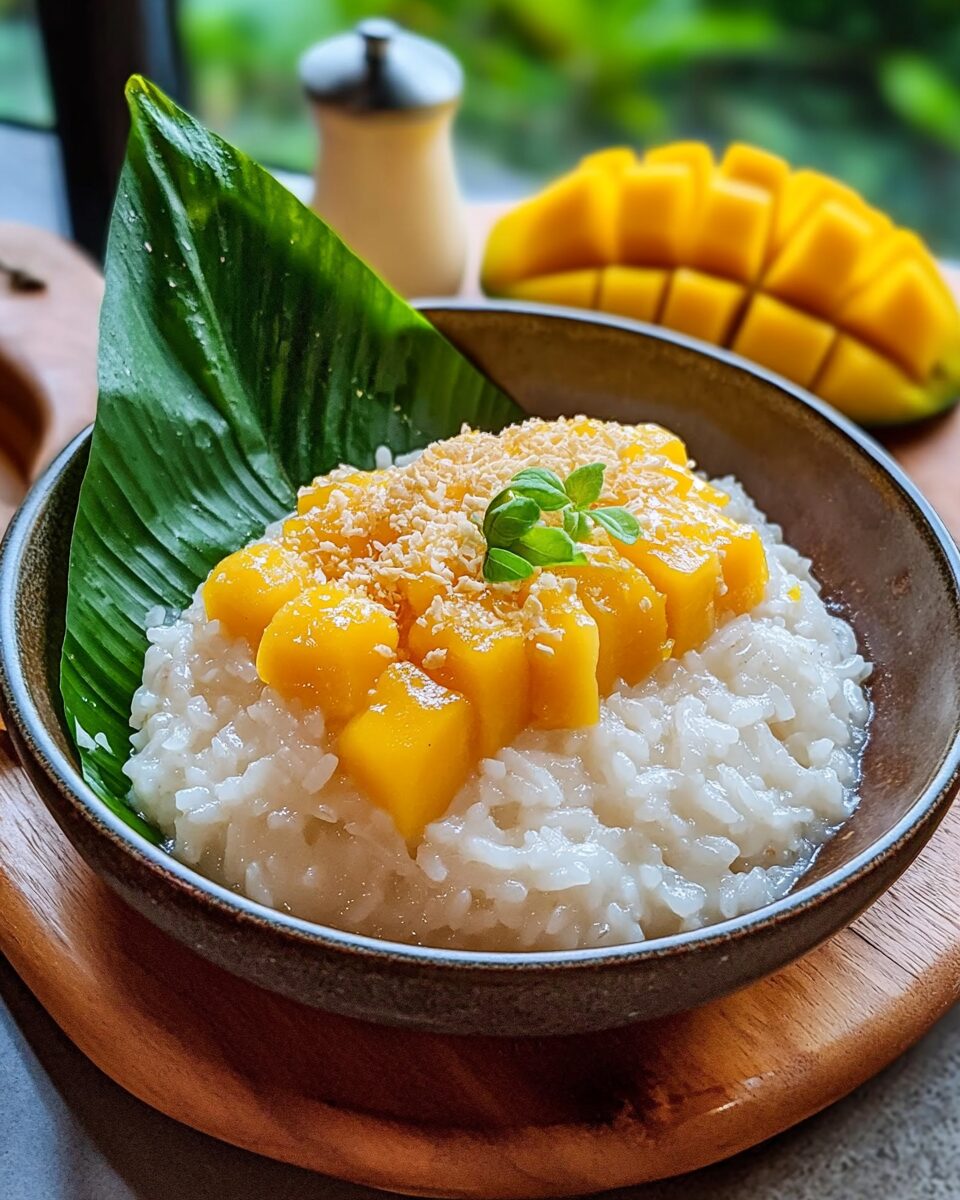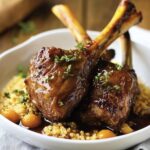Mango sticky rice is a classic Thai dessert that combines sweet coconut sticky rice with ripe, juicy mangoes. This simple yet delicious treat is often enjoyed during the summer months and is beloved for its balance of flavors and textures.
FULL RECIPE
Ingredients
- 1 cup sticky rice (also called glutinous rice)
- 1 ½ cups coconut milk
- ½ cup sugar
- ¼ teaspoon salt
- 2 ripe mangoes, peeled and sliced
- Sesame seeds or mung beans (optional, for garnish)
Directions
- Rinse the sticky rice thoroughly under cold water until the water runs clear.
- Soak the rice in water for 1-2 hours.
- After soaking, drain the rice and steam it in a bamboo or metal steamer for about 30 minutes, or until the rice is fully cooked and tender.
- While the rice is cooking, combine the coconut milk, sugar, and salt in a saucepan. Heat over medium-low heat until the sugar dissolves, but do not bring it to a boil.
- Once the rice is done, transfer it to a large bowl and pour the coconut milk mixture over it. Stir gently to combine and let it sit for 10-15 minutes to allow the rice to absorb the coconut milk.
- To serve, place a portion of sticky rice on a plate and top with fresh mango slices.
- Optionally, garnish with sesame seeds or mung beans for added texture and flavor.
Nutritional Information
- Calories: 330 per serving
- Carbohydrates: 70g
- Protein: 4g
- Fat: 8g
- Fiber: 2g
- Sugar: 30g
History of Mango Sticky Rice
Mango sticky rice, or “Khao Niew Mamuang” in Thai, is a beloved dessert with deep roots in Thai culinary culture. It has been enjoyed for centuries, symbolizing the tropical abundance of Thailand. Typically served in the summer months, especially during mango season from April to June, this dish is cherished across Thailand, particularly in Bangkok and the central regions.
Cultural Significance
Food in Thai culture is more than just sustenance—it’s a sign of hospitality and respect. Mango sticky rice is often shared at important gatherings, family events, and festivals. It’s a popular dessert during Thai New Year (Songkran), where it is passed around among friends and family, reflecting the festive spirit. The dish also holds a special place in Thai street food culture, with vendors serving it fresh in markets, particularly in cities like Bangkok.
Mango Varieties Used in Mango Sticky Rice
The type of mango used is key to achieving the perfect balance of sweetness and texture. The “Nam Dok Mai” mango, known for its smooth texture and sweet fragrance, is the most popular choice for this dessert. This mango variety is less fibrous than others, making it ideal for pairing with the sticky rice. In regions outside Thailand, other sweet and non-fibrous mangoes can be used as substitutes.
Sticky Rice and Its Role in Thai Cuisine
Sticky rice, or glutinous rice, is a staple in Thai cuisine. It has a unique, chewy texture and is typically steamed, making it perfect for desserts. It’s also used in savory dishes, such as papaya salad (Som Tum). The soft, sticky rice complements the rich, creamy coconut milk in mango sticky rice, providing a delightful contrast to the fresh mango slices.
Coconut Milk in Mango Sticky Rice
Coconut milk is essential to this dish. It adds creaminess and a mild sweetness, enhancing the flavor of the sticky rice. The coconut milk is often combined with sugar and a pinch of salt to create a sweet-savory sauce that’s poured over the rice. Fresh coconut milk is preferred for its richer taste, though canned versions can be used as an alternative.
The Textural Contrast of Mango Sticky Rice
A unique feature of mango sticky rice is its texture. The rice is soft and sticky, while the mango slices add a smooth, juicy element. The creamy coconut milk further enhances this contrast, creating a satisfying bite. Some variations of the dish include toppings like sesame seeds or mung beans, adding crunch and texture.
Street Food and Mango Sticky Rice
Mango sticky rice is a popular street food in Thailand. Vendors prepare it fresh to order, ensuring the rice is warm and the mangoes perfectly ripe. It’s served in various ways, from simple bowls with mango slices to more elaborate presentations with garnishes like toasted mung beans or sesame seeds. The dish’s accessibility and affordability have helped it become a favorite for locals and tourists alike.
Mango Sticky Rice as a Seasonal Delight
Traditionally, mango sticky rice is made during mango season when the fruit is at its peak. In Thailand, mango season typically runs from April to June. During this time, mangoes are abundant and their natural sweetness is at its best, making them the ideal pairing for the sticky rice. Although mango sticky rice can be enjoyed year-round outside of Thailand, the mangoes may not always be as sweet or fragrant.
Mango Sticky Rice in Modern Cuisine
Though it has traditional roots, mango sticky rice is also being reinvented by modern chefs. Some serve it with coconut ice cream as a topping, while others incorporate tropical fruits like dragon fruit or papaya. Creative chefs have even experimented with molecular gastronomy to create new textures and presentations while preserving the dish’s essence.
Health Benefits of Mango Sticky Rice
Mango sticky rice is not just delicious but also offers some nutritional benefits. Mangoes are rich in vitamin C, which boosts the immune system and promotes healthy skin. They also contain fiber, aiding in digestion. The sticky rice provides energy through carbohydrates, while the coconut milk offers healthy fats that are good for heart health. However, because of the high sugar content, it’s best enjoyed in moderation as part of a balanced diet.
Variations of Mango Sticky Rice
While the classic mango sticky rice recipe is simple—coconut milk, sugar, and salt—there are many regional variations. In some areas, the rice is flavored with pandan leaves, which give it a green color and a subtle fragrance. Some people add palm sugar or vanilla to the coconut milk for a different flavor profile, while others drizzle extra coconut cream on top for added richness.
Serving Mango Sticky Rice
Mango sticky rice is often served as a dessert or snack, though it can also be a light meal. It’s typically plated in small bowls or on plates, with the sticky rice and mango slices beautifully arranged. The rice should be served warm, not too hot, and the mango slices should be fresh and ripe. For added texture, toppings like sesame seeds, mung beans, or shredded coconut can be used as garnishes.
Mango Sticky Rice and Pairings
While mango sticky rice is usually enjoyed on its own, it can also be paired with other Thai dishes. Its sweetness complements the spiciness of Thai curries or the tanginess of papaya salad. For a refreshing drink, consider pairing it with Thai iced tea or coconut water, which balance the richness of the dessert.
Making Mango Sticky Rice at Home
Making mango sticky rice at home is relatively easy and rewarding. To get the best results, use high-quality sticky rice and ripe mangoes. If fresh coconut milk isn’t available, canned coconut milk can be used as a substitute. The rice should be steamed properly to achieve the ideal texture, and the coconut milk mixture should be gently stirred in to avoid over-saturating the rice.
Mango Sticky Rice Around the World
Mango sticky rice has gained international popularity and can now be found in restaurants and food festivals around the world. As interest in Thai cuisine grows globally, this dish has made its way to countries like the United States, the UK, and Australia. Its universal appeal highlights the richness of Thai food traditions.
Mango Sticky Rice for Special Occasions
In Thailand, mango sticky rice is often served during special occasions like Songkran (Thai New Year) or at weddings and birthdays. Its simplicity and elegance make it the perfect dessert for gatherings, where it can be shared among family and friends. The dish’s cultural significance adds to its charm, making it more than just a treat but a way to celebrate with loved ones.
Mango Sticky Rice in Thai Hospitality
Food is a symbol of hospitality in Thailand, and serving mango sticky rice to guests is a way of showing respect and appreciation. The dish is often part of a larger meal, alongside savory Thai dishes like curries or soups. Offering mango sticky rice as dessert allows guests to experience the harmonious flavors of Thai cuisine in one delightful bite.
The Popularity of Mango Sticky Rice in Thai Street Markets
Mango sticky rice is a fixture in Thai street markets, where vendors sell it fresh and ready to eat. The dish is often served in plastic containers or on banana leaves, making it easy for customers to enjoy while walking through the market. The vibrant color of the mango and the creamy rice make it visually appealing, and its affordability has made it a favorite among locals and tourists.
Conclusion
Mango sticky rice is more than just a dessert—it is a symbol of Thai culture and hospitality. The combination of sticky rice, coconut milk, and ripe mangoes creates a deliciously balanced dessert that is enjoyed around the world. Whether served on the streets of Thailand or made at home, mango sticky rice is a dish that brings people together, sharing the flavors of Thai culinary traditions. Its growing popularity worldwide proves its universal appeal, making it an enduring favorite for dessert lovers everywhere.






